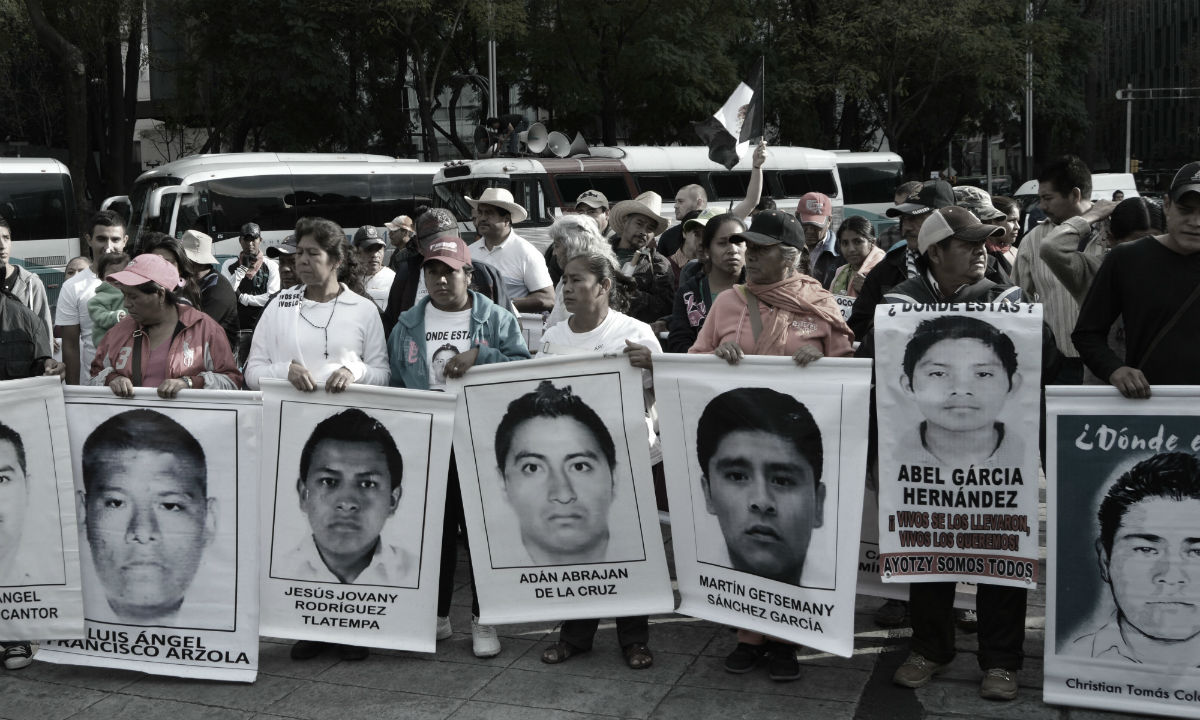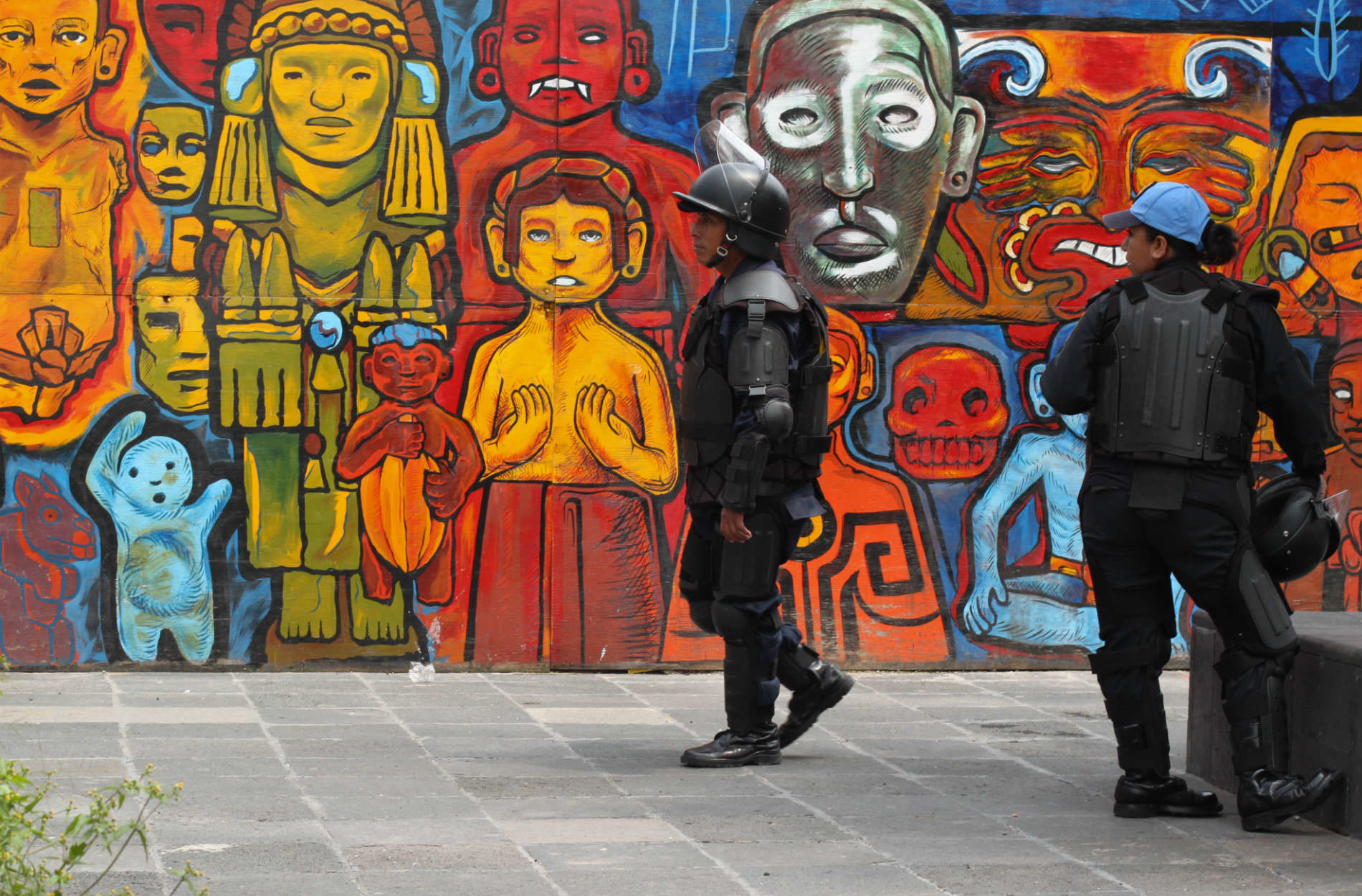‘What does it mean?’ I ask our tour guide as we pass another shop front in Oaxaca, southwest Mexico, bearing a graffiti slogan reading Faltan 43. ‘We’re missing forty-three,’ is the closest translation, he says.
At the mention of visiting Mexico – given that I was not simply planning to lie on a beach, drinking garish cocktails in the grossly Americanized Yucatán peninsula – the reaction was fairly consistent: a small, sharp, intake of breath, a slightly contorted expression and well-meant caution in the lines: ‘Be careful. It’s dangerous in Mexico.’
I spent around a month in this beautiful, troubled country. I went from the vibrant chaos of Mexico City to the eerie emptiness of the ruined Mesoamerican city of Teotihuacán, just thirty miles northeast of the sprawling metropolis; from the sub-zero mountain temperatures of San Cristobal to the stifling heat of the deeply spiritual town of Palenque near the Guatemala border; from the heart-wrenching poverty of street-hawkers in Mérida to the vulgar decadence of its eastern neighbor in Yucatán: Cancun.
I witnessed events that can perhaps only be described fairly from an outsider’s perspective as unusual. Not every day does one see a police officer removing the registration plate from a vehicle with a screwdriver and simply walking off with it, or does one observe teenagers stretching out razor wire across a meandering rural road, before attempting to stop traffic, and then extracting a fee to allow the driver’s onward passage.
And while one might expect in a country like Mexico for public buses to be boarded by armed passport control guards, it is perhaps less expected that eight of one’s fellow passengers are then led from the bus in handcuffs, an air of despondence on their faces betraying a sense of ‘so close, but yet so far’.
A Step Too Far: The Tragedy that Roused a Nation
Mexico does, however, have far more serious problems to contend with than dubious number plate removal, razor wire traffic management and failed border crossings. These more entrenched problems provoked the general agitation and restlessness that pervaded the country whilst I was there.
This tension was manifest in Mexico City, but could also be sensed in smaller, rural towns, where minor acts of defiance seemed to embody a general feeling of national discontent. The Faltan 43 graffiti, which at the time of my trip in November 2014 could be seen the length and breadth of Mexico, refers to forty-three students allegedly seized by local police in the south-western town of Iguala two months previously. It’s understood that the town’s mayor had instructed police officers to intercept the students as they travelled there to stage a protest. He had not wanted any interruption to a political rally being held by his wife the following morning, so it seemed. The students had planned protest against discriminatory hiring and funding practices within the Mexican education system. Student colleges in urban locations are claimed to occupy an unfairly privileged position in comparison with their rural counterparts.
En route to Iguala, the student teachers were intercepted by municipal police officers and a tussle ensued. The officers reportedly opened fire on the unarmed students, killing three of them and inadvertently, but fatally, wounding three bystanders. As a busload of the students attempted to flee the scene, they were chased by officers, bundled into vans and taken to the local police station. They weren’t seen again. Some have suggested that the police handed them on to a local drugs gang to be disposed of. So the version of events goes, the gang shot the students in the head before burning their bodies at a rubbish dump and scattering their ashes in a river.

Nos faltan 43, Photo by Fernando García
In the days before Faltan 43 began to appear, daubed on shop fronts, office blocks and even churches across Mexico, I had been working in the capital and had witnessed the mass protests relating to the student disappearances. Tens of thousands of stereotypically apathetic Mexicans had taken to the streets – some violently, certainly, but the majority peacefully – to protest not only about the missing forty-three, but also more generally about corruption and violence in the country. Mexico has become synonymous internationally in recent years, less with the clichéd sombrero, moustache and mariachi band, and more with drug wars and corruption in the ranks of law enforcement.
The ocean of colour made up of clothes, placards and banners gave the protest something of a carnival feel, as though the protestors were there in celebration rather than frustration and anger. The noise, however, was a constant reminder of the sinister underlying reason for this colourful explosion in the Zócalo, Mexico City’s vast central square. ‘¡Fue el Estado!’ they chanted repeatedly, accusingly. ‘It was the State’.
The Uphill Struggle for Human Rights Education
I am scheduled to interview one of the Directors of Education at the Comisión de Derechos Humanos del Distrito Federal: Mexico City’s education authority.
The interview is arranged only an hour prior to it happening. I’m warned that such practice is common in Mexico: administrative efficiency is not a priority here. My taxi driver speaks barely a word of English, and I barely a word of Spanish. Yet we somehow manage to settle upon a shared understanding of the reason for the gridlocked traffic. The ten-minute journey takes me just over forty-five minutes.
The Comisión sits to the far south of the sprawling capital. In a city where many important buildings are hidden from view behind vast opaque gates, the Comisión is surprisingly conspicuous. Its name and logo is emblazoned in large letters on the ornate stone wall that surrounds the building, with only a reception gate separating the main compound from the chaotic six-lane motorway outside. On the given day, I’m ushered through the gate with surprisingly effortless ease. In a country where armed policemen are often seen guarding convenience stores, and where most office blocks have security scanners similar to those more commonly found at airport departure gates, I expect to have to navigate a more labyrinthine system of security. After all, I’m entering a culturally and politically significant building.
I’m greeted inside the compound, not by the Director of Education herself, but by a more junior member of staff, Gabriella (which isn’t her real name). She seems timid and apologises repeatedly for her poor English, which is almost perfect. She informs me that the Director is stuck in traffic somewhere in the north of the city. The sheer size of the protests in the Zócalo has brought to a standstill one of the most populated cities on earth, it seems. Gabriella tells me she will do everything she can to give me the information I need.
I’m not here at the Comisión to talk about the student disappearances, the ongoing mass protests or corruption and violence in Mexico: I am here instead to talk about human rights education in the Mexican education system. Given the chaos taking place outside, and all across Mexico, the issue feels so trivial a topic of discussion. Gabriella, sitting opposite me in the empty office of her boss, has laminated photographs of the disappeared students safety-pinned to her otherwise unassuming beige skirt. In fact, everywhere one looks in the building – here on the walls, there sellotaped to idle computer monitors – the faces of the missing students stare back.
Teachers, Gabriella notes, comment disparagingly that ‘children have too many rights, and they’ll just start demanding that they have the right to candy’.
We talk about human rights education. Gabriella is enthusiastic about the work that the Comisión is doing in schools, trying to engage young learners in rights issues, and to enable them to recognise when their rights are being violated. Her passion for human rights education, her animated explanations of the educational activities that the Comisión has developed to engage young learners in this area – they are at odds with the sombre and reflective mood in the office. The vast open plan space we passed through to get here was not a hive of activity. It was eerily silent. No genial chatter. People looked anxious and exhausted.
For all her enthusiasm, Gabriella is cynical about the capacity of her small team to effect any genuine cultural change in the Mexican education system. She tells me about the Comisión’s attempts to educate teachers about rights, about the animosity they frequently encounter from those who just want to do their jobs without what they see as superfluous ‘nonsense’. She speaks about the workshops they run with police officers, at which they discuss acceptable (and unacceptable) uses of force. She tells me about how the courses are received with indifference at best, hostility at worst.
In this cultural climate, the Comisión struggles to truly make a difference, with children, with teachers or with the police. ‘There isn’t a culture of human rights in Mexico’, Gabriella says. Fostering such a culture within the education system is near impossible with the current restraints imposed by the federal government. Every educational right belongs to the federal government. Should the Comisión wish to introduce a new initiative in schools, it must first receive approval from above, and all school resources must be initially validated by the federal government. Resources seen as being remotely political, meanwhile, are simply not allowed. Approval is also required for organisations going into schools: NGOs find it difficult to obtain access, and political NGOs are never allowed beyond the gates.
Improving the reach of human rights education is therefore an ostensibly insurmountable task. Even if the first hurdle of state approval for relevant educational resources and practices is overcome, educators still face the more entrenched obstacle of an ingrained culture of suspicion towards human rights in Mexico. ‘Teachers are not very fond of the Comisión’, Gabriella tells me. ‘They don’t like us’. I ask her why. ‘Sometimes schools will say, “We are sick and tired of your courses and we don’t want them. What about my rights?”’ Teachers, Gabriella notes, comment disparagingly that ‘children have too many rights, and they’ll just start demanding that they have the right to candy’.
At the end of this long diatribe on institutional attitudes towards the Comisión’s workshops – and the idea of human rights more generally – Gabriella slumps down into her seat. She appears defeated by the long list of obstacles and setbacks that she has just described. The enthusiasm that characterised the start of our conversation has dissipated. She puts it quite simply that, ‘teachers just do not believe in human rights’.
why can’t they see that changing the human rights climate in Mexico is the only means by which real change will happen?’
I can claim only a meagre knowledge about Mexico, about its education system and its widespread public attitudes towards human rights. That said, I instantly recognise the weary resignation of an educator faced with an unresponsive and unengaged audience. It speaks a universal language. Gabriella, with the laminated photos of the forty-three students hanging from her clothing as a constant reminder of their plight, adds in a voice so quiet she could simply have been making the comment to herself: ‘Why can’t people see the connection?’ Again, I ask what she means.
‘Why can’t the people protesting, chanting “¡Fue el Estado!” and denouncing the misuse of state power that has propelled them onto the streets…why can’t they see that changing the human rights climate in Mexico is the only means by which real change will happen?’
Garbriella, suddenly animated once more, suggests that the Comisión will continue in its work. She believes that if they can change the attitude of just one teacher, it would signal progress. That teacher may be able, in turn, to empower a whole class of students to stand up for their own rights and for the rights of others. And those young people may be the catalyst for change that Mexico so desperately needs if it wishes to avoid a repeat of the Iguala tragedy.
Change: Risk and Necessity
Even such incremental change carries with it great risks, as the student disappearances so clearly demonstrate. These young teachers were trying to act as catalysts for change, but they paid the ultimate price for their efforts. Without a federal government that promotes and respects human rights, Mexico is likely to slip further into the grip of corruption and violence, which will no doubt be accelerated by a burgeoning drugs trade.
Faltan 42. The body of one of the missing students has since been formally identified from charred remains. That is one less laminated photograph for Gabriella to attach to her skirt or to fix to the walls of the Comisión. Yet it is no less of a burden for educators, like Gabriella, who can see clearly how change is possible. Her difficulty – their difficulty – lies in convincing others of their vision.
Photo by Geraint Rowland



